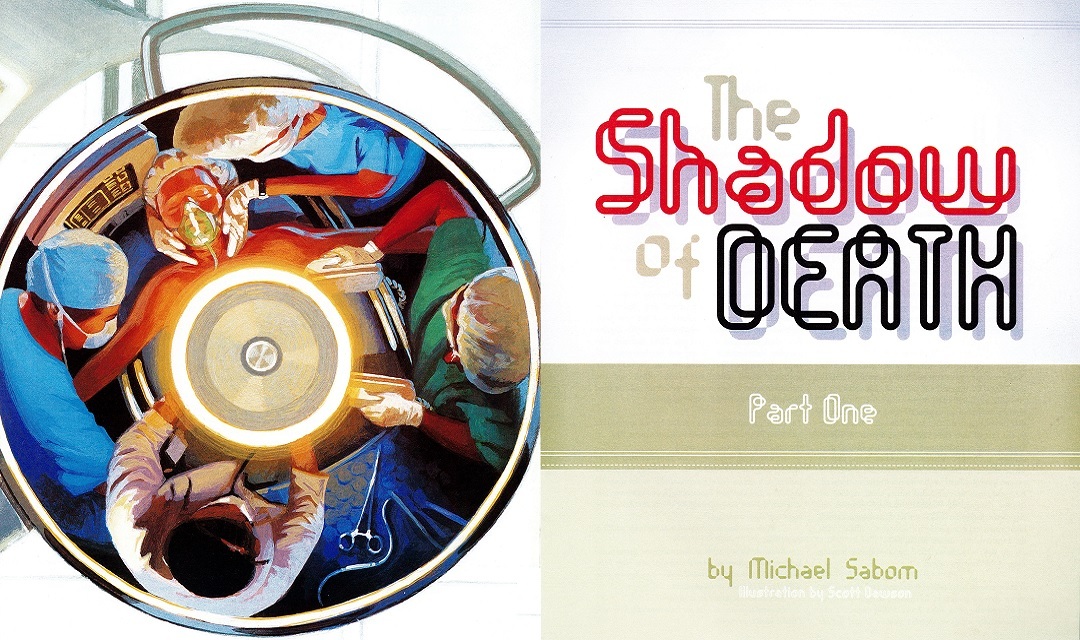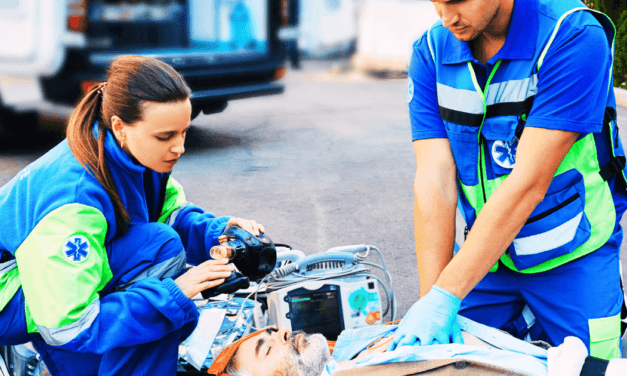This article first appeared in the Christian Research Journal, volume 26, number 2 (2003). For further information or to subscribe to the Christian Research Journal please click here.
SYNOPSIS
Considerable controversy has arisen over the causes and implications of the near-death experience (NDE). This controversy is fueled by the case of Pam Reynolds, who had an NDE during an operation in which her body temperature was dramatically lowered, the blood was drained from her head, and her brain had ceased to function. Was she dead or alive? Recent scientific research offers new insights into the question of when death occurs and what is experienced at or near death; nevertheless, the accuracy of purported “out-of-body” observations made while unconscious and without brain function is difficult to explain. Such findings challenge us to explain how an organized, coherent experience such as an NDE can arise in a disorganized or nonfunctioning brain. Perhaps science has missed a fundamental link between consciousness and the brain, or perhaps some experiences depend on the mind alone, which may not be inextricably bound up with the brain.
“The near-death experience proves to be a challenge to the materialism of modern science, just as it challenges those who are spiritually inclined to interpret its meaning properly.”1
— Douglas Groothuis
When I first read Life after Life2 by Raymond Moody, Jr., in 1976, I found it disturbingly unscientific. Snippets of conversations with “some 50 persons” had been used to substantiate far-reaching claims. No protocols had been followed, no data had been presented, and no medical details had been given. As a cardiologist with years of medical experience, moreover, I had never heard such tales from any of my own patients.
Challenged by friends, I reluctantly questioned resuscitated patients. My third interview uncovered a full-blown near-death experience (NDE). Intrigued by this unexpected result, I began research that has culminated in two major NDE studies reported in Recollections of Death and Light and Death.3 This two-part series will examine the current state of the NDE controversy from both a scientific and a spiritual standpoint.
THE CASE OF PAM REYNOLDS
The case of Pam Reynolds has been widely acclaimed as the “single best instance we now have in the literature on NDEs to confound the skeptics”4 and as the one coming “closest to providing solid, scientific evidence suggestive of the post-mortem survival of consciousness.”5 Pam was wheeled into the operating room at 7:15 a.m. on 8 August 1991 for repair of the first of two giant cerebral aneurysms by Robert Spetzler, chief of neurosurgery at the Barrow Neurological Institute in Phoenix, Arizona. A weakness in the walls of two arteries in her brain had caused the arteries to swell, and rupture was considered imminent. Anesthesia was induced. Both ear canals were occluded with a small, molded ear speaker designed to monitor brainstem function; an electroencephalogram (EEG) was set up to monitor cortical brain waves; and a unique electrical device was affixed to test the function of her cerebral hemispheres.6
At 8:40 a.m., Pam’s NDE began with the buzzing noise of the bone saw motor:
It was a natural D. As I listened to the sound, I felt it was pulling me out of the top of my head.…I remember seeing several things in the operating room when I was looking down.…I was metaphorically sitting on Spetzler’s shoulder. It was not like normal vision. It was brighter and more focused and clearer than normal vision.…There was so much in the operating room that I didn’t recognize, and so many people.…
The saw thing that I hated the sound of looked like an electric toothbrush and it had a dent in it, a groove at the top where the saw appeared to go into the handle, but it didn’t.…And the saw had interchangeable blades, too, but these blades were in what looked like a socket wrench case.…
I remember the heart-lung machine. I didn’t like the respirator.…I remember a lot of tools and instruments that I didn’t readily recognize.7
After cutting open the skull, Spetzler isolated the aneurysm. At 10:50 a.m., Pam was placed on cardiopulmonary bypass to quickly cool her core body temperature. As her temperature fell to 60 degrees Fahrenheit, her heart stopped, her EEG flattened into complete electrocerebral silence, and her brainstem and cerebral hemispheres became unresponsive. The head of the operating room table was then tilted up, the cardiopulmonary bypass machine turned off, and the blood drained from her body. Pam’s NDE progressed:
There was a sensation like being pulled, but not against your will. I was going on my own accord because I wanted to go.…It was like a tunnel but it wasn’t a tunnel.
At some point very early in the tunnel vortex I became aware of my grandmother calling me.…The feeling was that she wanted me to come to her, so I continued with no fear down the shaft. It’s a dark shaft that I went through, and at the very end there was this very little tiny pinpoint of light that kept getting bigger and bigger and bigger.
The light was incredibly bright, like sitting in the middle of a lightbulb.…
I noticed that as I began to discern different figures in the light — and they were all covered with light, they were light, and had light permeating all around them — they began to form shapes I could recognize and understand.…
They would not permit me to go further.…
I wanted to go into the light, but I also wanted to come back. I had children to be reared.8
After the blood had been drained from her body, the aneurysm collapsed, which allowed Spetzler to safely excise the empty sac. The cardiopulmonary bypass machine was turned back on, and the blood was rewarmed. Her vital signs and brain function returned with no evidence of a seizure. Still in her NDE, Pam recalls being led down the tunnel by her deceased uncle and reentering her chilled physical body as her heart was shocked back to normal rhythm. The operation ended at 2:10 p.m.
Nine days later, she underwent repair of the second cerebral aneurysm. This time hypothermic cardiac arrest was not necessary. While under anesthesia, tests of brainstem and cerebral hemispheric function showed “well maintained responses.” No NDE was reported.
THE MEDICAL DEFINITION OF DEATH
According to the “whole brain” definition of death, life ends with the “cessation of all functions of the entire brain.”9 During her first surgery, Pam’s brain had been drained of blood and found “dead” by all clinical tests of brain function. According to Spetzler, “If you would examine that patient from a clinical perspective during that hour [of hypothermic cardiac arrest], that patient would by all definition be dead.”10
Addressing the question of when death begins, Harvard internist Linda Emanuel writes:
The reigning view [of death] has assumed that life and death are nonoverlapping, dichotomous states. This view acknowledges that dying may take time, but presumes that a threshold event is nevertheless definable; a person is thought to be either alive or dead, not both.…Is there an event that can identify final and complete loss of life? The answer appears to be no.…The process of dying occurs at different levels of organization, from the organism to the organ, cellular, and subcellular levels, and each set of systems can decline on a somewhat independent trajectory.11
Scientific observations support Emanuel’s contention. Ten “brain dead” organ donors demonstrated significant changes in blood pressure and heart rate in response to the harvesting of their organs — reactions only possible with portions of the brain intact.12 In nonhuman vertebrates, moreover, “suspended animation” (i.e., complete cessation of all microscopically observable cell motility and division) has been induced and then reversed after prolonged periods of oxygen deprivation.13
Death is a process — it does not occur at a single moment in time. The determination of death rests on the premise of reversibility: if the person recovers, then by this convention that person never was dead, regardless of the absence of vital signs or brain function. Doctors do not resurrect their patients; rather, they resuscitate them. Based on this definition, Pam encountered a near-death experience, not an after-death experience.
THE NEAR-DEATH EXPERIENCE
Five studies typify the scientific research examining NDEs: (1) psychologist Kenneth Ring’s 1980 report of 102 persons (49 near-death experiencers [NDErs]);14 (2) my 1982 report of 116 persons (71 NDErs);15 (3) my 1998 report of 160 persons (47 NDErs);16 (4) Dutch cardiologist Pim van Lommel’s 2001 report of 344 persons (62 NDErs);17 and (5) British cardiologist Sam Parnia’s 2001 report of 63 persons (4 NDErs).18 Near-death crisis events (NDCEs) included serious illnesses, accidents, or suicide attempts, with cardiac arrest the most common diagnosis.
In my first study, I defined an NDE as any definite “recollection from the period of unconsciousness” associated with physical near-death. The NDE was more stringently defined in the later studies using two strongly correlated scoring systems.19 NDEs were reported by 39 to 43 percent of near-death survivors in the earlier studies, and by 6 to 18 percent in later studies. These variations were most likely due to differences in research methods, subject selection, and definition of NDE. NDE content was remarkably consistent in each study and corresponded to one or more elements in Moody’s classic prototype reported in Life after Life.20 These elements appeared in three patterns: autoscopic (i.e., a self-visualizing, out-of-body experience [OBE]), transcendental (entering a dark region, seeing a light, etc.), and combined (autoscopic followed by transcendental). Standardized NDE scales were used to assess the “depth” of the experience.21
The report of an NDE is not related to a person’s gender, race, education, occupation, previous knowledge of these experiences, type of NDCE, method of resuscitation, or interval between the NDCE and the interview. (Religious variables will be discussed in part two of this series.) Older subjects recovering from lengthy resuscitations report fewer NDEs, apparently due to a greater loss of short-term memory following NDCEs in this age group.22
Compared to those near-death survivors who did not have an NDE, NDErs report a significantly greater reduction in their fear of death following a NDCE,23 and a significantly greater increase in their sense of meaning in life, search for personal meaning, desire to help others, compassion and tolerance for others, ability to listen to and to express love for others, understanding and acceptance of others, and involvement in family life.24
THE AUTOSCOPIC NDE: FACT OR FANTASY?
In my first study, 32 subjects described an autoscopic OBE.25 Twenty-six gave broad “visual” impressions of their resuscitation that lacked sufficient detail for analysis. Six persons claimed to have “seen” specific resuscitative details during their OBEs, including, (1) the placement of an oxygen mask (“They had oxygen on me before, one of those little nose tubes, and they took that off and put on a face mask which covers your mouth and nose.”); (2) a chest thump followed by external cardiac massage and insertion of airway (“He hit me right in the center of my chest. And then they were pushing on my chest…kinda like artificial respiration. They shoved a plastic tube, like you put in an oil can, they shoved that in my mouth.”); (3) defibrillator paddles (“Well, they weren’t paddles….They were round discs with handles on them.”); (4) lubrication of the paddles (“They put something on those pads like a lubricant.”); (5) positioning of the paddles (“They put one up here…and they put one down here.”); (6) charging the defibrillator (“I think they moved the fixed needle and it stayed still while the other one moved up.”); (7) defibrillation (“I thought they had given my body too much voltage. Man, my body jumped about two feet off the table.”); (8) injection of intracardiac medications (“They put a needle in me and…shoved it into my chest like that.”); (9) checking for pupillary response and carotid pulse (“They were pulling my eyelids up to look to see where my eyes were, I guess.…Then they were feeling around my neck where the pulse is.”); (10) insertion of a subclavian vein catheter (“Dr. B came up and decided to put one in my left — well, not in my armpit, but on my side.”); and (11) drawing arterial blood gases from the femoral artery (“shots first in the groin down there somewhere”) and radial artery (“the little needle they were putting in my hand. Something about the blood gases.”).
When compared to medical records and cardiopulmonary resuscitation (CPR) protocol, these reports turned out to be surprisingly accurate. It is unlikely that visual details of the objects and events reported in these NDEs would have been either discussed by others present during the resuscitation or observed by the deeply arrested patient.
Pam Reynolds’s NDE, moreover, began at a time when she had been heavily anesthetized with both ears occluded and eyes taped shut. Her portrayal of the Midas Rex bone saw as “an electric toothbrush,” of the instrument case as “a socket wrench case” containing “interchangeable blades,” and of the sound of the Midas Rex motor as a “natural D” were all surprisingly accurate descriptions of this surgical instrument.26 She also recalls, “Someone said something about my veins and arteries being very small. I believe it was a female voice and that it was Dr. Murray, but I’m not sure.” Spetzler noted in his operative report, “Simultaneous with the opening of the craniotomy, Dr. Murray performed bilateral femoral cut-downs for cannulation for cardiac bypass [i.e., obtaining access to blood vessels to insert arterial and venous catheters].” Murray noted separately in her report that Pam’s “quite small” femoral vessels necessitated “bilateral groin cannulation” and that this unexpected twist “was discussed with Neurosurgery.”27 The starting of the bone saw thus coincided with the onset of the craniotomy, with the conversation between Murray and Spetzler, and with the autoscopic portion of Pam’s NDE. This precise correspondence of events during a six-hour operation is remarkable.
Pam described her NDE to her mother during the first few days after surgery. Her mother gave me a copy of Spetzler’s operative report but insisted that Pam had never looked at it. Neither woman had a copy of Murray’s report containing the note about “small blood vessels,” making this an unlikely source for Pam’s information. Could Spetzler or one of his assistants have told Pam of these details? When asked, Spetzler replied, “It is possible but not probable.”28
EYEWITNESS TESTIMONY
If the autoscopic NDE is a true “eyewitness” account, then an analogy can be drawn between an eyewitness to a crime and an NDEr’s visualization of a medical procedure. In both situations, the person is afforded a brief glimpse of an unexpected and unfamiliar scene under stressful circumstances, often involving a “weapon” (a gun or knife in the case of a crime; an unusual and/or threatening instrument or procedure in the case of medicine).
Crime research has shown that eyewitness testimony is most reliably obtained when the witness is allowed to give a free, unstructured account of events.29 Furthermore, witness confidence in the account has been positively correlated with its accuracy.30 Under the best of circumstances, however, human perception is imprecise. The accuracy of eyewitness identification of the perpetrator of a crime in a lineup falls from 56 percent when no weapon was present at the crime scene to 35 percent when a weapon was present. The weapon, however, is accurately recalled 91 percent of the time. This variance has been attributed to a “weapon focus” phenomenon, with the gun or knife being a “salient-object attention distracter.”31
In my research, each NDEr was initially allowed to describe the experience in a free, unstructured format. NDEr confidence in these reports appeared quite high: “it was realer than real,” “clearer than normal vision,” “this is no figment of my imagination.” These autoscopic NDE reports focused on “salient” objects and events, with the high accuracy of reported details corresponding to high NDEr confidence in the reports.
Pam’s description of the bone saw, however, was not “picture perfect.” She described it as “an electric toothbrush and it had a dent in it, a groove at the top where the saw appeared to go into the handle, but it didn’t.” When viewed from a distance, this saw indeed appears to be an electric toothbrush;32 however, although its tip does have an overhanging edge that looks somewhat like a groove if viewed from the side, this overhang is not at the top. In my opinion, this flaw in Pam’s description lends credibility to the explanation that her recollection is based on her imperfect observation of this small instrument while in use instead of on a photograph or some other surreptitious source that may have afforded a more perfect description.
Could these accurate autoscopic reports of CPR be “false memory”33 accounts based on the “best guess” efforts of previously hospitalized patients? To check for this, 25 seasoned coronary care unit patients, with backgrounds similar to the NDE group but who had not encountered an NDE, were asked to describe CPR from the standpoint of an onlooker in the corner of a hospital room.34 Confidence in these descriptions appeared to be low. Two of the patients described nothing. Without undue prompting, 20 of the remaining 23 patients made major errors in describing salient objects and events: “mouth to mouth breathing” for artificial respiration; “wooden throat paddles, like an ice cream stick, only bigger” for an oral airway; “a blow to the back to get the heart beating again”; “opening up the chest to place the hands around the heart and massage it”; “electric shock would be given through those wires which are fastened onto the chest and hooked up to the cardiac monitor”; “the electric shock would be given through a needle stuck in the heart through the chest”; the defibrillator paddles “would be hooked up to an air tank and pressurized” or “they would have a suction cup on the bottom of them.” It would seem, therefore, that the accuracy of NDE testimonies more closely resembles true eyewitness reports than accounts that would be expected from patients who had not directly witnessed the event.
BRAIN FUNCTION AND THE NDE
Psychological, physiological, and pharmacological explanations of the NDE have been reviewed in this journal35 and elsewhere.36 The conditions described by each of these explanations may stimulate the brain in such a way that bears some resemblance to part of the NDE, yet none affords an adequate overall explanation.
Can a physical brain mechanism ever be shown with certainty to cause an NDE? Radiologist Andrew Newberg has extensively studied brain function during spiritual experiences using nuclear imaging techniques. He has concluded: “It’s no safer to say that spiritual urges and sensations are caused by brain activity than it is to say that the neurological changes through which we experience the pleasure of eating an apple cause the apple to exist.…There is no way to determine whether the neurological changes associated with spiritual experiences mean that the brain is causing those experiences…or is instead perceiving a spiritual reality.”37
Despite this uncertainty, something can be said about brain function and the NDE. Neuropsychiatrist Peter Fenwick has noted:
Messages about the outside world come from the sense organs and are relayed to the brain. The brain uses this information to create a model of the world…[F]or a sensory experience to come into con-sciousness it has to make its way to the appropriate analysis system in the [brain] cortex.…Each brain area contributes part of the picture of our experienced world.…To bring a complete model of the world into consciousness the brain has to be working as a whole in an integrated way. If one area is damaged then its particular function will be absent or distorted, and so too will that part of the “world model.”38
Model building, moreover, ceases altogether with unconsciousness.
Following a cardiac arrest, consciousness is lost, and the EEG becomes isoelectric (i.e., flat) within nine to twenty-one seconds.39 In-hospital CPR (especially in the 1970s) begins within minutes, not seconds, after a cardiac arrest; thus, it is safe to assume that brain modeling was not occurring while the autoscopically viewed CPR procedures were in progress. If the NDE is yet another “model” built by the physical brain, however, then the same rules should apply as to other forms of cognitive experience — that is, it must be “modeled” when brain function is intact.
Perhaps such modeling of an NDE occurs immediately before consciousness is lost. Prior to loss of consciousness, experimental subjects who underwent cardiac arrest felt “distant, dazed, and as if they were fading out.”40 Other subjects, rendered unconscious during medical experimentation (extreme head-to-foot acceleration in a human centrifuge), experienced tunnel vision with contraction of the visual field from the periphery inward followed by blackout.41 Short dream interludes were reported by some centrifuge subjects, but these “dreamlets” were confused, fragmented, and often incorporated ongoing physical sensations into dream content.
These loss-of-consciousness experiences appear to result from a progressive loss of brain modeling. They are unlike an autoscopic NDE, which one NDEr described as “an immediate transition” from being semiconscious, in physical pain, and watching “from where my head is on the pillow,” to feeling physically unconscious, without pain, and “up in the air looking down at all this commotion going on around my bed.”42 It seems unlikely, moreover, that the autoscopic NDE is modeled immediately after consciousness is regained, since “time-to-awakening after CPR ranges from 5 minutes to 72 hours with a median time of 6 hours,”43 which is long after the autoscopically reported events had occurred.
Psychologist Susan Blackmore has proposed that during unconsciousness, “the normal model of reality breaks down and the system [i.e., the brain] tries to get back to normal by building a new model from memory and imagination. If this model is from a bird’s eye view, then an out-of-body experience takes place.” NDErs reporting an OBE, therefore, “should be those who use bird’s-eye views more in imagination and dreaming” than nonautoscopic NDErs.44
Psychologist William Serdahely refuted Blackmore’s hypothesis. He noted that memory and imagination are constructed from everyday experience and that everyday experience is most commonly registered in a “field memory” (i.e., perception of oneself looking out from inside the body) and not an “observer memory” (i.e., perception of observing oneself from outside the body) mode. The autoscopic NDE, therefore, should frequently be “nonautoscopic” — that is, an in-the-body or “field memory” experience.45 My finding that autoscopic NDErs were no more likely to dream in the observer memory mode than NDErs without an autoscopic experience further discounted Blackmore’s hypothesis.46
Fenwick concludes that the major question remains unanswered: “How is it that this coherent, highly structured experience sometimes occurs during unconsciousness, when it is impossible to postulate an organized sequence of events in a disordered brain? One is forced to the conclusion that either science is missing a fundamental link which would explain how organized experiences can arise in a disorganized brain, or that some forms of experience are transpersonal — that is, they depend on a mind which is not inextricably bound up with the brain.”47
In part two of this series, I will examine the religious controversies within the field of near-death studies and evaluate the scientific data in light of the Word of God.
Michael Sabom, M.D., is a cardiologist in private practice in Atlanta, Georgia.
NOTES
- Douglas Groothuis, Deceived by the Light (Eugene, OR: Harvest House, 1995), 179.
- Raymond Moody, Jr., Life after Life (Covington, GA: Mockingbird, 1975).
- Michael Sabom, Recollections of Death: A Medical Investigation (New York: Harper & Row, 1982); Michael Sabom, Light and Death: One Doctor’s Fascinating Account of Near-Death Experiences (Grand Rapids: Zondervan, 1998).
- Kenneth Ring, “Religious Wars in the NDE Movement: Some Personal Reflections on Michael Sabom’s Light and Death,” Journal of Near-Death Studies 18, 4 (2000): 218.
- Michael Schmicker, Best Evidence (Lincoln, NE: IUniverse, 2001), 183.
- For more on these devices and procedures, see Leon Liem, “Intraoperative Neurophysiological Monitoring,” http://www.emedicine.com/neuro/topic102.htm.
- Sabom, Light and Death, 41–42.
- Ibid., 43–45.
- “Uniform Determination of Death Act,” drafted by the National Conference of Commissioners on Uniform State Laws, Kauai, Hawaii, 26 July–1 August 1980.
- CBS News, 48 Hours, 20 November 1997.
- Linda Emanuel, “Reexamining Death: The Asymptotic Model and a Bounded Zone Definition,” Hastings Center Report 25 (1995): 27–
- Randall Wetzel et al., “Hemodynamic Responses in Brain Dead Organ Donor Patients,” Anesthesia and Analgesia 64 (1985): 125–
- A. Padilla and M. B. Roth, “Oxygen Deprivation Causes Suspended Animation in the Zebrafish Embryo,” Proceedings of the National Academy of Sciences of the United States of America 98, 13 (2001): 7331–35.
- Kenneth Ring, Life at Death (New York: Coward, McCann and Geoghegan, 1980).
- Sabom, Recollections of Death.
- Sabom, Light and Death.
- Pim van Lommel et al., “Near-Death Experience in Survivors of Cardiac Arrest: A Prospective Study in the Netherlands,” The Lancet 358 (2001): 2039–45.
- Sam Parnia et al., “A Qualitative and Quantitative Study of the Incidence, Features, and Aetiology of Near Death Experiences in Cardiac Arrest Survivors,” Resuscitation 48 (2001): 149–56.
- Bruce Greyson, “The Near-Death Experience Scale: Construction, Reliability, and Validity,” Journal of Nervous and Mental Disease 171 (1983): 369–75; Ring, Life at Death, 32–36.
- Moody, 23–62.
- Greyson 369–75; Ring, Life at Death, 32–36.
- Van Lommel, 2043.
- Sabom, Recollections of Death, 213. (The level of significance for this comparison was p < 001.)
- Sabom, Light and Death, 227. (The level of significance for this comparison was p < 01.)
- Sabom, Recollections of Death, 81–115.
- Ibid., 188; CBS News, 48 Hours.
- Sabom, Light and Death, 184–85.
- Robert Spetzler in a 2002 letter to John C. Gibbs, Ph.D., professor of developmental psychology, Ohio State University. Gibbs provided me with a copy of the letter and granted permission for me to quote from it.
- Jack Lipton, “On the Psychology of Eyewitness Testimony,” Journal of Applied Psychology 62, 1 (1977): 90–95.
- K. Bothwell, K. A. Deffenbacher, and J. C. Brigham, “Correlation of Eyewitness Accuracy and Confidence: Optimality Hypothesis Revisited,” Journal of Applied Psychology 72, 4 (1987): 691–95.
- Thomas Kramer, Robert Buckhout, and Paul Eugenio, “Weapon Focus, Arousal, and Eyewitness Memory,” Law and Human Behavior 14, 2 (1990): 167–84.
- Sabom, Light and Death, 187.
- Richard Abanes, Journey into the Light (Grand Rapids: Baker Books, 1996), 124–28.
- Sabom, Recollections of Death, 84–86.
- Isamu Yamamoto, “The Near-Death Experience (Part Two): Alternative Explanations,” Christian Research Journal 15, 1 (1992): 14–16, 18–19, 29.
- See Sabom, Recollections of Death, 151–78; Sabom, Light and Death, 175–91.
- Sharon Begley, “God and the Brain,” Newsweek, 7 May 2001, 52–57.
- Peter Fenwick and Elizabeth Fenwick, The Truth in the Light (New York: Berkley Books, 1997), 199–207.
- Aminoff et al., “Electrocerebral Accompaniments of Syncope Associated with Malignant Ventricular Arrhythmias,” Annals of Internal Medicine 108 (1988): 791–96; Jaap de Vries et al., “Changes in Cerebral Oxygen Uptake and Cerebral Electrical Activity during Defibrillation Threshold Testing,” Anesthesia and Analgesia 87 (1998): 16–20.
- Aminoff, 791–96.
- James Whinnery, “Psychophysiologic Correlates of Unconsciousness and Near-Death Experiences,” Journal of Near-Death Studies 15, 4 (1997): 231–58.
- Sabom, Light and Death, 56, 60–61.
- Mary Sauve et al., “Patterns of Cognitive Recovery in Sudden Cardiac Arrest Survivors: The Pilot Study,” Heart Lung 25, 3 (1996): 172–81.
- Susan Blackmore, Dying to Live (Buffalo, NY: Prometheus Books, 1993), 180.
- William Serdahely, “Questions for the Dying Brain Hypothesis,” Journal of Near Death Studies 15, 1 (1996): 41–53.
- Sabom, Light and Death, 184.
- Fenwick, 235.









